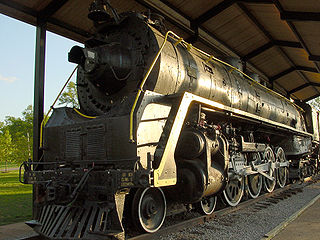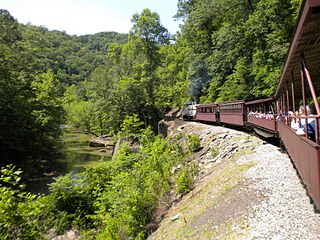The Cleveland, Cincinnati, Chicago and St. Louis Railway, also known as the Big Four Railroad and commonly abbreviated CCC&StL, was a railroad company in the Midwestern United States. It operated in affiliation with the New York Central system.

The Chesapeake and Ohio Railway was a Class I railroad formed in 1869 in Virginia from several smaller Virginia railroads begun in the 19th century. Led by industrialist Collis P. Huntington, it reached from Virginia's capital city of Richmond to the Ohio River by 1873, where the railroad town of Huntington, West Virginia, was named for him.

The Illinois Central Railroad, sometimes called the Main Line of Mid-America, was a railroad in the Central United States. Its primary routes connected Chicago, Illinois, with New Orleans, Louisiana, and Mobile, Alabama, and thus, the Great Lakes to the Gulf of Mexico. Another line connected Chicago west to Sioux City, Iowa (1870), while smaller branches reached Omaha, Nebraska (1899) from Fort Dodge, Iowa, and Sioux Falls, South Dakota (1877), from Cherokee, Iowa. The IC also ran service to Miami, Florida, on trackage owned by other railroads.

The Nashville, Chattanooga and St. Louis Railway was a railway company that operated in the U.S. states of Kentucky, Tennessee, Alabama, and Georgia. It began as the Nashville and Chattanooga Railroad, chartered in Nashville on December 11, 1845, built to 5 ft gauge and was the first railway to operate in the state of Tennessee. By the turn of the twentieth century, the NC&StL grew into one of the most important railway systems in the southern United States.

The Louisville and Nashville Railroad, commonly called the L&N, was a Class I railroad that operated freight and passenger services in the southeast United States.
The Clinchfield Railroad was an operating and holding company for the Carolina, Clinchfield and Ohio Railway. The line ran from the coalfields of Virginia and Elkhorn City, Kentucky, to the textile mills of South Carolina. The 35-mile segment from Dante, Virginia, to Elkhorn City, opening up the coal lands north of Sandy Ridge Mountains and forming a connection with the Chesapeake and Ohio Railway at Elkhorn City, was completed in 1915.

The Paducah & Louisville Railway is a Class II railroad that operates freight service between Paducah and Louisville, Kentucky. The line is located entirely within the Commonwealth of Kentucky.

The Big South Fork Scenic Railway is a heritage railroad in Stearns, Kentucky.

The Canada Southern Railway, also known as CSR, was a railway in southwestern Ontario, Canada, founded on February 28, 1868 as the Erie and Niagara Extension Railway. Its name was changed to Canada Southern Railway on December 24, 1869. The 1868 Act specified that it was to be constructed at a broad gauge of 5 ft 6 in, but that requirement was repealed in the 1869 Act, thus allowing construction at the standard gauge of 4 ft 8+1⁄2 in.

The George Washington was a named passenger train of the Chesapeake and Ohio Railway running between Cincinnati, Ohio and Washington, D.C. that operated from 1932, the 200th anniversary of the birth of George Washington, to 1974. A section divided from the main train at Gordonsville, Virginia and operated through Richmond to Phoebus, Virginia. From the west, a section originated in Louisville and joined at Ashland.
The following is a brief history of the North American rail system, mainly through major changes to Class I railroads, the largest class by operating revenue.
The Paducah, Tennessee and Alabama Railroad was formed in July 1889 by the merger of the decades-old Paducah and Tennessee Railroad Company of Kentucky, with the newly established Paducah and Tennessee Railway and Paducah and Tennessee Railroad Companies of Tennessee. Construction began in 1890 at Paducah, Kentucky, and the road was completed to Lexington, Tennessee, in November 1892, totaling 118.61 miles (190.88 km) of track.
The Elizabethtown and Paducah Railroad was a 19th-century railway company in western Kentucky in the United States. It operated from 1867 to 1874, when it was purchased by the Louisville, Paducah and Southwestern Railroad. It later made up part of the Illinois Central network and its former rights-of-way currently form parts of the class-II Paducah and Louisville Railway.
The Louisville, Paducah and Southwestern Railroad was a 19th-century railway company in western Kentucky in the United States. It operated from 1874, when it purchased the Elizabethtown and Paducah, until 1876, when it was purchased by the Paducah and Elizabethtown. It later made up part of the Illinois Central network and its former rights-of-way currently form parts of the class-II Paducah and Louisville Railway.
The Paducah and Elizabethtown Railroad was a 19th-century railway company in western Kentucky in the United States. It operated from 1877, when it purchased the Louisville, Paducah and Southwestern Railroad, until 1882, when it was purchased by the Chesapeake, Ohio and Southwestern Railroad. It later made up part of the Illinois Central network and its former rights-of-way currently form parts of the class-II Paducah and Louisville Railway.
The Chicago, St. Louis and New Orleans Railroad was a 19th- and early-20th-century railway company in Kentucky in the United States. It operated from 1877 and was created from the merger of the Mississippi Central Railroad and the New Orleans, Jackson & Great Northern Railroad until 1882, when control was obtained by the Illinois Central.

Chesapeake and Ohio Railway 2716 is a class "K-4" 2-8-4 "Kanawha" (Berkshire) type steam locomotive built in 1943 by the American Locomotive Company (ALCO) for the Chesapeake and Ohio Railway (C&O). While most railroads referred to these 2-8-4 type locomotives as Berkshires, the C&O referred to them as Kanawhas after the Kanawha River, which flows through West Virginia. Used as a dual service locomotive, No. 2716 and its classmates served the C&O in a variety of duties until being retired from revenue service in 1956.
Lexington Union Station was a union station, serving most of the railroads passing through Lexington, Kentucky. Located on Main Street, just west of Walnut Street it served the Chesapeake and Ohio Railway and the Louisville and Nashville Railroad from 1907 to 1957.
Transport and bus boycotts in the United States were protests against the racial segregation of transport services. These occurred before the passage of the 1964 Civil Rights Act, which outlawed such forms of discrimination.









